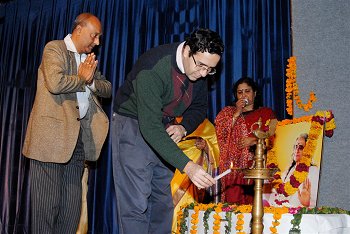 |
 |
Indo European Dance Festival by AIPA February 27, 2010 
Baroque dance is theatrical and social dancing of the European upper classes from around 1650 - 1760. In practice, it often means the style originating in France. The style includes both social (ballroom) dancing and theatrical dancing (ballet). Sentiments play a very important role in baroque music and dance. The treatises of eighteenth century philosophers and composers mention 8 sentiments. These are: love, sorrow, joy, anger, emotion and crying, fear and horror, violence and impudence and admiration. From them stem other emotions and feelings, which artistes expressed in music and dance. Baroque is a separate, though related, dance form with a different aesthetic, and although the basic steps themselves are technically easier than the steps of ballet, there is still much work involved in making a sequence of steps into a dance that is worthy of an audience. As to the "difficulty" of a virtuoso theatre dance, this will always tend to a level that is determined by the skill of the best performers. "It is a unique and important idea to demonstrate to the public, the relationship between the European as well as Indian court dance forms in the 17th and 18th century. The two dance forms are similar not only in expressions but also in moods, sensibility and share the same dream about beauty. It is one of the ideal ways to bring to the notice of the contemporary public, about the rich European and Indian dance traditions," says Baroque dance artiste Romana Agnel from Poland. Renaissance dances belong to the broad group of historical dances. It usually refers to the earliest European dances. The Renaissance court dances include the first choreographies that could be considered ballets. During the renaissance period, there was a distinction between country dances and court dances. Court dances required the dancers to have been trained and were often for display and entertainment, whereas country dances could be attempted by anyone. Knowledge of court dances has survived better than that of country dances as they were collected by dancing masters in manuscripts and later in printed books. The dances in these manuals are extremely varied in nature. They range from slow, stately dances (bassadance, pavane, almain) to fast, lively dances (galliard, coranto, canario). The former, in which the dancers' feet did not leave the ground were styled the dance basse while energetic dances with leaps and lifts were called the haute dance. Some were choreographed, others were improvised on the spot. Renaissance dance artiste Marie-Claire Le Corre from France, is very enthusiastic about the festival. "It is indeed very exciting since the festival marks a culmination of three different forms of dance on a common platform." "The festival aims at modern, contemporary and classical dance to merge on the stage to form a magnificent mélange of styles. Participants of various age groups have been a part of the festival that included a full week of various dance workshops culminating in two nights of performance. This multicultural presentation is a source of cultural pride for AIPA as it provides a common platform to learn the dance forms from Poland (Baroque dance) and France (Renaissance) by internationally acclaimed masters Romana Agnel and Marie-Claire Le Corre. I strongly believe that through the arts, we can educate people and build bridges across boundaries," says Alaknanda Bose, Director of AIPA and curator of the festival. Alaknanda Institute for Performing Arts (AIPA) has a 20 year proven track record of promoting art and culture not only within India but also across the boundaries with due affiliation from Akhil Bharatiya Gandharva Mahavidyalaya, Mumbai. Having successfully trained students in different disciplines in the field of art like Kathak, Hindustani vocal music, and musical instruments like tabla, guitar and keyboard to name a few, AIPA is now exploring the global arena to promote Indian art and culture amongst foreign students. |